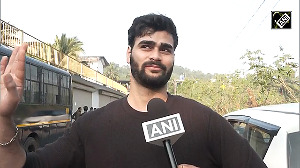Arjun Divecha, the man at the helm of affairs at GMO Emerging Markets Fund with $15 billion under its fold, is unwilling to bet on a paradigm shift in India. Going by the statistical odds instead, he is underweight on the country.
Divecha, based in Berkeley, California, is a member of the GMO board and executive committee and is responsible for overseeing the team managing the GMO Emerging Markets Fund, the GMO Emerging Countries Fund and the GMO Emerging Markets Quality Fund which currently have over $15 billion under management for global institutional clients.
Armed with a Bachelors degree in Aeronautical Engineering from the Indian Institute of Technology, Bombay and an MBA in Finance from Cornell University, Divecha has been affiliated with GMO since 1993. Prior to this, Divecha spent 12 years at BARRA directing software development, marketing, client service and emerging markets research and development. Divecha shares his investment strategy and how he views Indian markets right now.
Can you give us a glimpse of your investment strategy?
In emerging markets, we believe that getting the country right is more important than everything else. So we use 70 per cent of our risk units to make country bets and 30 per cent to pick stocks within those countries. We buy countries and stocks that are cheap and those that have positive momentum in their fundamentals as well as their prices.
At the country level we also take into account how a country is doing from a macroeconomic point of view. We believe in macroeconomic reversion to the mean - countries that have been growing at a rate faster than their long term average are likely to disappoint and countries that have been growing below their long term average are likely to surprise on the upside.
We also avoid countries that have expensive currencies and are vulnerable to some kind of crisis. We then use quadratic portfolio optimization techniques to build portfolios that bet on countries and stocks that are high in value and momentum while minimizing risk and transaction costs. (Quadratic portfolio optimisation technique is an quantitative tool used to generate a portfolio which can generate the best expected return for a specified risk level)
What is your benchmark index and how closely do you track it?
The S&P/IFC Emerging Markets Investable Index is our benchmark. We target a level of tracking error of between 8-10 per cent (monthly return annualized) in order to be able to deliver outperformance of around 4 per cent annually above the index.
What does your portfolio look like right now?
Like I said, by and large we don't focus on sectors, but on countries. As a result, we do not have significant bets on any sector currently. The countries we are most overweight today are Korea, Brazil, Taiwan and Turkey. The markets we are most underweight are Russia, India, Israel and South Africa.
What are the risks to global equity market performance right now?
I think there are considerable risks to global equities - specifically overvaluation of the US equity market, high oil prices and some kind of China crisis. It could even be some unforeseen new and horrible terrorist action. For the past few months, I have been surprised at how little impact oil prices have had on both corporate profits and stock prices in oil importing countries. Sooner or later it will start to bite, in my opinion. I just can't say when.
In the last couple of years all emerging markets have enjoyed large inflows because there was an environment of "risk love" where risky assets were sought after and highly rewarded - some call this the "Greenspan put". In my opinion, Mr Greenspan has now withdrawn this "free insurance." So this liquidity boom will reverse at some point and cause money to move away from risky assets such as emerging markets.
What are risks for India?
In the past, India would have been isolated from many of these effects, but over the last few years India has become more integrated into the world economy and capital markets. So it will not escape the vicissitudes of global contagion this time around.
Where does India stand compared to other emerging markets today?
As I mentioned earlier, we believe that countries that have been growing above their long term averages tend to disappoint, because people's expectations get too inflated and make them overlook a multitude of sins.
Thus, while fundamentals look extremely good in India, history tells us to bet on a reversion to the mean. India is the most expensive emerging market right now based on our valuation metrics. Between these two (macroeconomics and valuation), India looks pretty unattractive to us.
Could you be wrong about reversion to the mean in India?
Definitely. If India is truly in the middle of a paradigm shift to a secularly higher growth rate, then today's valuations will not prove to have been expensive in retrospect and we will be wrong about being underweight now.
As an IIT Bombay graduate, I'd rather play the statistical odds (reversion to the mean) than bet on a paradigm shift (that things will in fact be different this time).
As Sir John Templeton famously said, the four most dangerous words in the English language are, "This time it's different". While fund flows have been very positive, it's an effervescent indicator - it can change in a day.
The longer your investment horizon, the less relevant fund flows are to your strategy while changes in fundamentals have greater relevance. As value investors, we tend to have an average holding period of 18 months, thus what matters to us is changes in reality, rather than changes in perception.
How do broad markets look in India?
When you look at valuations of stocks in the index, they are higher than their peers in other emerging markets, thereby anticipating a higher level of growth. Thus, in order to find the broad market attractive, you would have to make the case that these companies will grow at a rate quite a bit faster than other emerging market stocks.
As I mentioned in the previous question, things may turn out that way, but I'm not really willing to act on that assumption.
How do you view the mid-cap segment?
The great advantage of India for investors is that there are so many listed companies with great growth opportunities outside of the large index stocks.
As a result, one can frequently find value in smaller and midcap companies. We particularly like sectors that will benefit from infrastructure development such as construction, real estate development and power generation. But when the tide goes out, watch out for the high flyers.
Do you think India's stock valuations can hold up even if foreign flows slow down?
In the short run, probably not, but at the end of the day what matters is whether Indian companies deliver earnings growth that justifies their lofty valuations. One must understand that flows follow fundamentals, not the other way around.
| RESEARCH CALLS
RAYMOND'S It owns respected brands like Raymond's, Color Plus, Park Avenue, Parx and Mazoni and has a massive retail distribution network. Moreover, earnings are expected to grow at a 47 per cent CAGR (FY05-07). With its sound business model, strong balance sheet and large cash holdings, Raymond's is well placed to exploit the opportunities in the post-quota era. The report believes that a host of catalysts could lead to a re-rating in the stock's valuations. The company's fabric division is likely to report a 11.3 per cent CAGR in sales over FY05-07. Due to its vertically integrated model, Raymond's has strong expertise and understanding of key issues across the value chain. The stock trades at 12x FY07E earnings. NOIDA TOLL BRIDGE Implementation of Mayur-Vihar Link project would result in incremental traffic of 10,000 vehicles per day. Approval of the development rights of land adjoining the bridge could prove to be a major cash driver. The company is expected to break-even at net profit level in FY07E and any incremental revenues would directly add to the bottom-line. But the two parallel bridges, viz. Nizamuddin Bridge and Okhla Barrage, which fall within the influence area of DND flyway and are free to use, continue to pose competition relating to the traffic growth on DND flyway. The company is in possession of 100 acres land adjoining the bridge, which can be developed with the permission of the regulatory authority. GOKALDAS EXPORTS The report feels that the current scenario has improved the pricing environment in certain restricted categories that would lead to margin expansion for Gokaldas Exports. Order book position for the company for Autumn-Winter season stood at Rs 410 crore (Rs billion). Revenue growth of 20 per cent per annum is expected over the next two years. Margin pressure is likely to ease as pricing improves. EBITDA margin is expected to improve by 50 bps to 9.2 per cent in FY07E. Buyer concentration continues to decline. Capex program is on schedule. Production lines are expected to go up from 270 to 320 by FY06E and eventually to 360 by FY07E. The stock trades at 17x FY06E earnings of Rs 30.9. |






